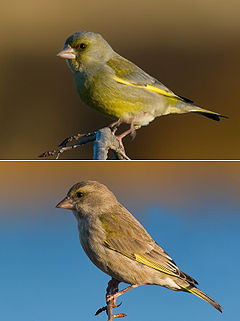- European Greenfinch
-
European Greenfinch 
Male above, female below Conservation status Scientific classification Kingdom: Animalia Phylum: Chordata Class: Aves Order: Passeriformes Family: Fringillidae Genus: Carduelis Species: C. chloris Binomial name Carduelis chloris
(Linnaeus, 1758)Synonyms Chloris chloris (but see article text)
The European Greenfinch, or just Greenfinch, Carduelis chloris, is a small passerine bird in the finch family Fringillidae. The genus Carduelis might be split up and in this case, the greenfinches would be separated in their old genus Chloris again.
This bird is widespread throughout Europe, north Africa and south west Asia. It is mainly resident, but some northernmost populations migrate further south. The Greenfinch has also been introduced into both Australia and New Zealand.
Woodland edges, farmland hedges and gardens with relatively thick vegetation are favoured for breeding. It nests in trees or bushes, laying 3-8 eggs.
This species can form large flocks outside the breeding season, sometimes mixing with other finches and buntings. They feed largely on seeds, but also take berries and seeds.
The Greenfinch is 15 cm in length with a wing span of 24.5-27.5 cm and is similar in size and shape to a House Sparrow,[2] but is mainly green, with yellow in the wings and tail. The female and young birds are duller and have brown tones on the back. The bill is thick and conical. The song contains wheezes and twitters, and the male has a "butterfly" display flight.
Contents
Etymology
Chloris from the Greek Khloros meaning "green" or "yellowish-green".[3]
Phylogeny
It has been obtained by Antonio Arnaiz-Villena et al. [4][5][6]
Gallery
Origin of greenfinches
See Desert finch.
References
- ^ BirdLife International (2004). Carduelis chloris. 2006. IUCN Red List of Threatened Species. IUCN 2006. www.iucnredlist.org. Retrieved on 2008-06-02.
- ^ The Birds of the Western Palearctic [Abridged]. OUP. 1997. ISBN 019854099X.
- ^ Jobling, James A (1991). A Dictionary of Scientific Bird Names. OUP. ISBN 0 19 854634 3.
- ^ Arnaiz-Villena, Antonio; Alvarez-Tejado M., Ruiz-del-Valle V., García-de-la-Torre C., Varela P, Recio M. J., Ferre S., Martinez-Laso J. (1998). "Phylogeny and rapid Northern and Southern Hemisphere speciation of goldfinches during the Miocene and Pliocene Epochs". Cell.Mol.Life.Sci. 54(9):1031-41. http://chopo.pntic.mec.es/biolmol/publicaciones/goldfinches2.pdf.
- ^ Arnaiz-Villena, A; Zamora J, Ernesto L, Ruiz-del-Valle V, Moscoso J, Serrano-Vela JI, Rivero-de-Aguilar J (2006). "Rhodopechys obsoleta (desert finch): a pale ancestor of greenfinches(Carduelis spp.) according to molecular phylogeny". Journal of Ornithology 147, no 3. p. 448-456.. http://chopo.pntic.mec.es/biolmol/publicaciones/desert-finch.pdf.
- ^ Zamora, J; Moscoso J, Ruiz-del-Valle V, Ernesto L, Serrano-Vela JI, Ira-Cachafeiro J, Arnaiz-Villena A (2006). "Conjoint mitochondrial phylogenetic trees for canaries Serinus spp. and goldfinches Carduelis spp. show several specific polytomies". Ardeola 53(1): 1–17. http://chopo.pntic.mec.es/biolmol/publicaciones/conjoint.pdf.
External links
- European Greenfinch videos, photos & sounds on the Internet Bird Collection
- Ageing and sexing (PDF) by Javier Blasco-Zumeta
Categories:- IUCN Red List least concern species
- Carduelis
- Birds of Europe
- Birds of Asia
- Birds of Africa
- Birds of Turkey
Wikimedia Foundation. 2010.











